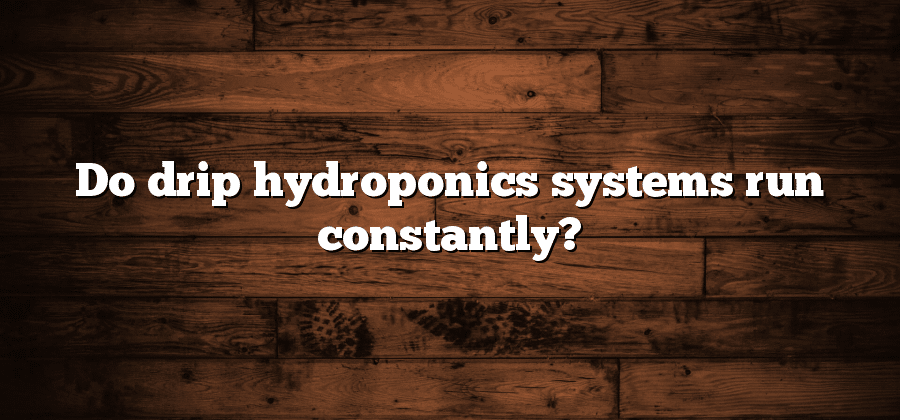The Mechanics of Drip Hydroponics Systems
Drip hydroponics systems, also known as drip irrigation systems, are an efficient and effective way to deliver water and nutrients directly to the roots of plants. These systems consist of a network of tubes or pipes, usually made of plastic, that are strategically placed to ensure even distribution of water and nutrients. The main component of the system is the delivery mechanism, which can be in the form of drip emitters, micro-sprinklers, or adjustable drippers.
The mechanics of drip hydroponics systems primarily revolve around the proper flow and control of water. A water pump is used to supply a continuous flow of water from a reservoir to the main line of the system. From the main line, smaller tubes or pipes are connected to deliver water to individual plants or plant containers. The flow rate of water can be adjusted at each individual plant, allowing for precise control over the amount of water delivered. Additionally, a timer can be used to control the frequency and duration of each watering session, ensuring that plants receive the optimal amount of water and nutrients for their growth and development.
Understanding the Basics of Drip Hydroponics
When it comes to hydroponics, many enthusiastic gardeners are turning to drip systems for efficient and precise plant cultivation. Drip hydroponics is a method that allows for controlled nutrient delivery directly to the roots of plants, offering numerous advantages compared to traditional soil-based growing.
The basic principle of drip hydroponics involves using a network of tubes or pipes to deliver a continuous flow of nutrient-rich water directly to each plant’s root system. This targeted approach ensures that plants receive an optimal amount of water and nutrients, eliminating any waste or excess runoff. The system operates on a simple yet effective mechanism: a pump, usually connected to a timer, is used to drip the nutrient solution onto the roots at specified intervals throughout the day. This allows growers to maintain precise control over the amount and frequency of watering, ensuring that plants receive the perfect balance of nutrients for their growth.
Optimal Operation of Drip Hydroponics Systems
To achieve optimal operation of drip hydroponics systems, it is essential to focus on several key factors. Firstly, it is crucial to maintain the correct nutrient solution concentration. Regular monitoring of the nutrient solution’s pH and electrical conductivity (EC) levels is necessary to ensure that the plants receive an adequate balance of essential minerals and nutrients. By regularly testing and adjusting these levels, growers can promote healthy plant growth and prevent nutrient deficiencies or toxicities.
Secondly, proper irrigation management is essential for the optimal operation of drip hydroponics systems. One important aspect is determining the ideal watering schedule. This involves considering factors such as plant species, growth stage, environmental conditions, and container size. Finding the balance between supplying enough water to meet the plants’ needs while avoiding waterlogging is critical. Additionally, analyzing the watering intervals is crucial. By monitoring and adjusting the frequency and duration of irrigation cycles, growers can ensure that plants receive water in a timely and efficient manner, promoting optimal growth and nutrient uptake.
Determining the Ideal Watering Schedule
One crucial aspect in the successful operation of drip hydroponics systems is determining the ideal watering schedule. Although there is no one-size-fits-all solution, there are key factors to consider when establishing a suitable schedule for your specific setup. Watering frequency, duration, and timing all play significant roles in this process.
Firstly, it is important to understand the specific needs of the plants being grown in your system. Different types of plants require varying amounts of water and have unique stages of growth. For instance, leafy greens such as lettuce may require more frequent watering, while fruiting plants like tomatoes may have different watering needs during different stages of fruit development. Therefore, it is crucial to research and understand the water requirements of each crop, enabling you to tailor the watering schedule accordingly.
Analyzing the Watering Intervals in Drip Hydroponics
One of the key factors in successful drip hydroponics systems is determining the ideal watering intervals. The frequency and duration of watering sessions play a critical role in providing plants with the right amount of moisture and ensuring optimal growth. However, finding the perfect balance can be challenging as it requires a thorough understanding of the plants’ water needs, environmental conditions, and the specifics of the drip system itself.
To analyze watering intervals in drip hydroponics, it is essential to consider various factors. First and foremost, the plant’s stage of growth should be taken into account. Seedlings and young plants require more frequent watering to establish their roots and encourage healthy development. As the plants mature, the watering intervals can be gradually adjusted to meet their changing needs. Additionally, factors such as temperature, humidity, and airflow in the hydroponic environment can affect the rate of water evaporation and absorption, making it necessary to adapt the watering schedule accordingly.






